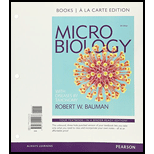
Microbiology with Diseases by Taxonomy, Books a la Carte Plus Mastering Microbiology with Pearson eText -- Access Card Package (5th Edition)
5th Edition
ISBN: 9780134402789
Author: Robert W. Bauman Ph.D.
Publisher: PEARSON
expand_more
expand_more
format_list_bulleted
Question
Chapter 18, Problem 2SA
Summary Introduction
To determine:
The reason that a child born to a
Introduction:
In humans, the blood group is categorized under four groups are found: A, B, AB, and O.
These blood groups are categorized on the basis of the presence or absence of surface protein. The other factor in categorizing the blood groups is
Expert Solution & Answer
Want to see the full answer?
Check out a sample textbook solution
Students have asked these similar questions
What Rh antigen is present in the red blood cells of this type of blood?
How is Rh incompatibility involved in hemolytic disease of the newborn? Is the mother Rh+ or Rh-? Is the fetus Rh+ or Rh-? Why is a second child that is Rh+ more susceptible to attack from the mother’s immune system.
How does a baby inherit Rh+ blood from an Rh− mother?
Chapter 18 Solutions
Microbiology with Diseases by Taxonomy, Books a la Carte Plus Mastering Microbiology with Pearson eText -- Access Card Package (5th Edition)
Ch. 18 - Prob. 1MCCh. 18 - Prob. 2MCCh. 18 - Prob. 3MCCh. 18 - Prob. 4MCCh. 18 - Prob. 5MCCh. 18 - Prob. 6MCCh. 18 - Prob. 7MCCh. 18 - Prob. 8MCCh. 18 - Prob. 9MCCh. 18 - Prob. 10MC
Ch. 18 - Prob. 1TFCh. 18 - Prob. 2TFCh. 18 - Prob. 3TFCh. 18 - Prob. 4TFCh. 18 - Prob. 5TFCh. 18 - Prob. 1MCh. 18 - Prob. 1SACh. 18 - Prob. 2SACh. 18 - Prob. 3SACh. 18 - Prob. 4SACh. 18 - Prob. 5SACh. 18 - Prob. 1VICh. 18 - Prob. 2VICh. 18 - What possible advantages might an individual gain...Ch. 18 - Why cant physicians use skin tests similar to the...Ch. 18 - Prob. 3CTCh. 18 - Prob. 4CTCh. 18 - What types of illnesses cause death in patients...Ch. 18 - Prob. 6CTCh. 18 - Prob. 7CTCh. 18 - Prob. 8CTCh. 18 - A 43-year-old woman has been diagnosed with...Ch. 18 - Prob. 1CMCh. 18 - Prob. 1TMWCh. 18 - Prob. 2TMWCh. 18 - Prob. 3TMWCh. 18 - Prob. 1CCS
Knowledge Booster
Similar questions
- why are the children of Rh positive mothers not at risk for this erythroblastosis fetalisarrow_forwardWhy it is necessary for an Rh− woman who has had anabortion, miscarriage, or an ectopic pregnancy to be immunizedagainst the Rh factor?arrow_forwardWhy might it be advisable for an Rh–woman who has had an abortion,miscarriage, or an ectopic pregnancy to be immunized against the Rhfactor?arrow_forward
- Briefly explain the significance of RH factor. Why mother with Rh negative blood should receive RhoGAM shot? What type of antibodies would be produced in this case? Why there is no universal donor anymore? What type of blood you can transfuse if patient has type A- blood?arrow_forwardWhat are all the possible genotypes of an individual with type A blood? (We are not considering Rh factor for these problems)arrow_forward
arrow_back_ios
arrow_forward_ios
Recommended textbooks for you
 Human Heredity: Principles and Issues (MindTap Co...BiologyISBN:9781305251052Author:Michael CummingsPublisher:Cengage Learning
Human Heredity: Principles and Issues (MindTap Co...BiologyISBN:9781305251052Author:Michael CummingsPublisher:Cengage Learning Human Physiology: From Cells to Systems (MindTap ...BiologyISBN:9781285866932Author:Lauralee SherwoodPublisher:Cengage Learning
Human Physiology: From Cells to Systems (MindTap ...BiologyISBN:9781285866932Author:Lauralee SherwoodPublisher:Cengage Learning

Human Heredity: Principles and Issues (MindTap Co...
Biology
ISBN:9781305251052
Author:Michael Cummings
Publisher:Cengage Learning

Human Physiology: From Cells to Systems (MindTap ...
Biology
ISBN:9781285866932
Author:Lauralee Sherwood
Publisher:Cengage Learning
